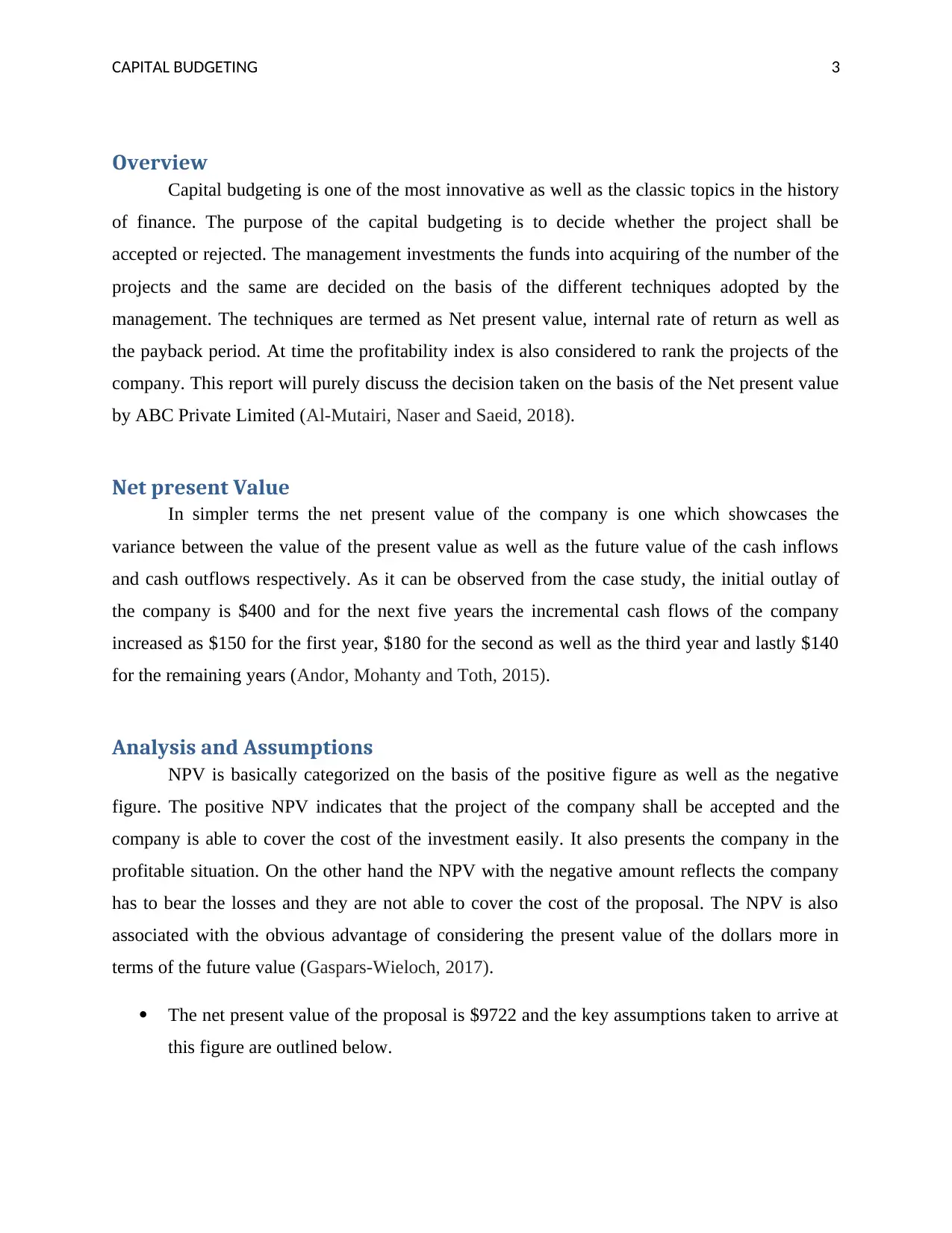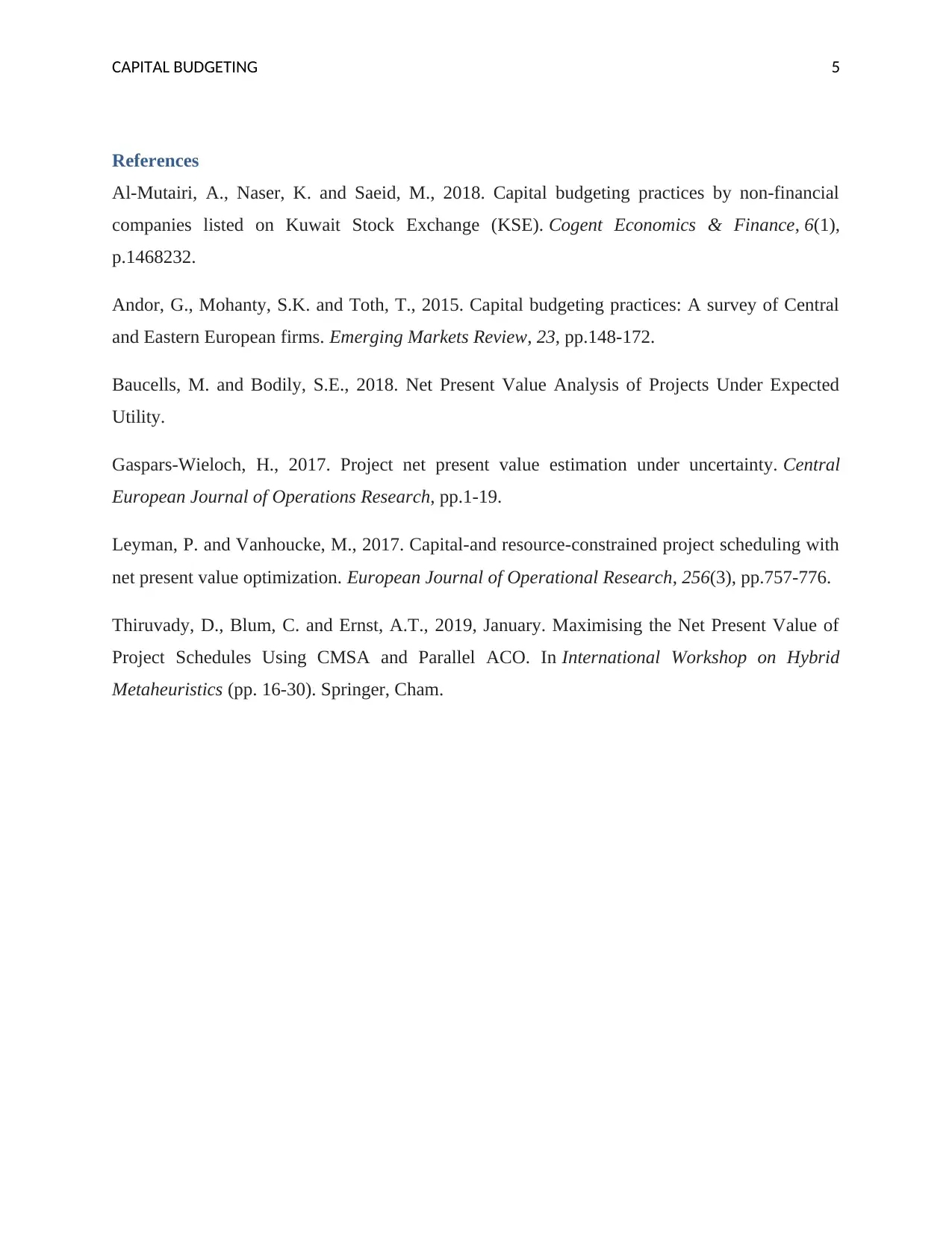BAO5734 Financial Analysis: Capital Budgeting Project Report
VerifiedAdded on 2023/02/01
|5
|838
|67
Report
AI Summary
This report focuses on capital budgeting, specifically analyzing a project for ABC Private Limited using the Net Present Value (NPV) method. It begins with an overview of capital budgeting, highlighting its importance in financial decision-making. The report then delves into the NPV calculation, explaining how it determines the present value of future cash flows to assess project viability. The initial investment outlay is specified, along with projected cash flows over five years. The analysis section discusses the assumptions made, such as depreciation calculations, the use of a 5.56% discounting factor derived from the WACC method, and the inclusion of net working capital and salvage value. The report concludes that the project is acceptable, with a positive NPV of $9722, which is expected to increase the company's value. The references cited provide additional context to the analysis.

Running head: CAPITAL BUDGETING 1
CAPITAL BUDGETING
CAPITAL BUDGETING
Paraphrase This Document
Need a fresh take? Get an instant paraphrase of this document with our AI Paraphraser

CAPITAL BUDGETING 2
Table of Contents
Overview.....................................................................................................................................................3
Net present Value........................................................................................................................................3
Analysis and Assumptions...........................................................................................................................3
Conclusion...................................................................................................................................................4
References...................................................................................................................................................5
Table of Contents
Overview.....................................................................................................................................................3
Net present Value........................................................................................................................................3
Analysis and Assumptions...........................................................................................................................3
Conclusion...................................................................................................................................................4
References...................................................................................................................................................5

CAPITAL BUDGETING 3
Overview
Capital budgeting is one of the most innovative as well as the classic topics in the history
of finance. The purpose of the capital budgeting is to decide whether the project shall be
accepted or rejected. The management investments the funds into acquiring of the number of the
projects and the same are decided on the basis of the different techniques adopted by the
management. The techniques are termed as Net present value, internal rate of return as well as
the payback period. At time the profitability index is also considered to rank the projects of the
company. This report will purely discuss the decision taken on the basis of the Net present value
by ABC Private Limited (Al-Mutairi, Naser and Saeid, 2018).
Net present Value
In simpler terms the net present value of the company is one which showcases the
variance between the value of the present value as well as the future value of the cash inflows
and cash outflows respectively. As it can be observed from the case study, the initial outlay of
the company is $400 and for the next five years the incremental cash flows of the company
increased as $150 for the first year, $180 for the second as well as the third year and lastly $140
for the remaining years (Andor, Mohanty and Toth, 2015).
Analysis and Assumptions
NPV is basically categorized on the basis of the positive figure as well as the negative
figure. The positive NPV indicates that the project of the company shall be accepted and the
company is able to cover the cost of the investment easily. It also presents the company in the
profitable situation. On the other hand the NPV with the negative amount reflects the company
has to bear the losses and they are not able to cover the cost of the proposal. The NPV is also
associated with the obvious advantage of considering the present value of the dollars more in
terms of the future value (Gaspars-Wieloch, 2017).
The net present value of the proposal is $9722 and the key assumptions taken to arrive at
this figure are outlined below.
Overview
Capital budgeting is one of the most innovative as well as the classic topics in the history
of finance. The purpose of the capital budgeting is to decide whether the project shall be
accepted or rejected. The management investments the funds into acquiring of the number of the
projects and the same are decided on the basis of the different techniques adopted by the
management. The techniques are termed as Net present value, internal rate of return as well as
the payback period. At time the profitability index is also considered to rank the projects of the
company. This report will purely discuss the decision taken on the basis of the Net present value
by ABC Private Limited (Al-Mutairi, Naser and Saeid, 2018).
Net present Value
In simpler terms the net present value of the company is one which showcases the
variance between the value of the present value as well as the future value of the cash inflows
and cash outflows respectively. As it can be observed from the case study, the initial outlay of
the company is $400 and for the next five years the incremental cash flows of the company
increased as $150 for the first year, $180 for the second as well as the third year and lastly $140
for the remaining years (Andor, Mohanty and Toth, 2015).
Analysis and Assumptions
NPV is basically categorized on the basis of the positive figure as well as the negative
figure. The positive NPV indicates that the project of the company shall be accepted and the
company is able to cover the cost of the investment easily. It also presents the company in the
profitable situation. On the other hand the NPV with the negative amount reflects the company
has to bear the losses and they are not able to cover the cost of the proposal. The NPV is also
associated with the obvious advantage of considering the present value of the dollars more in
terms of the future value (Gaspars-Wieloch, 2017).
The net present value of the proposal is $9722 and the key assumptions taken to arrive at
this figure are outlined below.
⊘ This is a preview!⊘
Do you want full access?
Subscribe today to unlock all pages.

Trusted by 1+ million students worldwide

CAPITAL BUDGETING 4
The depreciation is calculated on the basis of the salvage value deduction form the cost of
the investment and divided the value to find out the rate of the depreciation. The rate was
required as the diminishing value method is followed (Thiruvady, Blum and Ernst, 2019).
The depreciation is added back to the value of the annual cash flows as the depreciation is
the non-cash expense.
The discounting factor selected is 5.56% which has been arrived using the WACC
method (Baucells and Bodily, 2018).
The net working capital and the salvage value are added in the last year to arrive at the
final value of the cash flows.
The feasibility study is included as it is the fixed expense and it was bound to be paid by
the company for any kind of research undertaken.
Conclusion
Hence from the overall analysis it can be concluded that the proposal can be accepted by the
company as the Net Present Value is of the positive nature at $9722 and it will definitely
increase the value of the company in future (Leyman and Vanhoucke, 2017).
The depreciation is calculated on the basis of the salvage value deduction form the cost of
the investment and divided the value to find out the rate of the depreciation. The rate was
required as the diminishing value method is followed (Thiruvady, Blum and Ernst, 2019).
The depreciation is added back to the value of the annual cash flows as the depreciation is
the non-cash expense.
The discounting factor selected is 5.56% which has been arrived using the WACC
method (Baucells and Bodily, 2018).
The net working capital and the salvage value are added in the last year to arrive at the
final value of the cash flows.
The feasibility study is included as it is the fixed expense and it was bound to be paid by
the company for any kind of research undertaken.
Conclusion
Hence from the overall analysis it can be concluded that the proposal can be accepted by the
company as the Net Present Value is of the positive nature at $9722 and it will definitely
increase the value of the company in future (Leyman and Vanhoucke, 2017).
Paraphrase This Document
Need a fresh take? Get an instant paraphrase of this document with our AI Paraphraser

CAPITAL BUDGETING 5
References
Al-Mutairi, A., Naser, K. and Saeid, M., 2018. Capital budgeting practices by non-financial
companies listed on Kuwait Stock Exchange (KSE). Cogent Economics & Finance, 6(1),
p.1468232.
Andor, G., Mohanty, S.K. and Toth, T., 2015. Capital budgeting practices: A survey of Central
and Eastern European firms. Emerging Markets Review, 23, pp.148-172.
Baucells, M. and Bodily, S.E., 2018. Net Present Value Analysis of Projects Under Expected
Utility.
Gaspars-Wieloch, H., 2017. Project net present value estimation under uncertainty. Central
European Journal of Operations Research, pp.1-19.
Leyman, P. and Vanhoucke, M., 2017. Capital-and resource-constrained project scheduling with
net present value optimization. European Journal of Operational Research, 256(3), pp.757-776.
Thiruvady, D., Blum, C. and Ernst, A.T., 2019, January. Maximising the Net Present Value of
Project Schedules Using CMSA and Parallel ACO. In International Workshop on Hybrid
Metaheuristics (pp. 16-30). Springer, Cham.
References
Al-Mutairi, A., Naser, K. and Saeid, M., 2018. Capital budgeting practices by non-financial
companies listed on Kuwait Stock Exchange (KSE). Cogent Economics & Finance, 6(1),
p.1468232.
Andor, G., Mohanty, S.K. and Toth, T., 2015. Capital budgeting practices: A survey of Central
and Eastern European firms. Emerging Markets Review, 23, pp.148-172.
Baucells, M. and Bodily, S.E., 2018. Net Present Value Analysis of Projects Under Expected
Utility.
Gaspars-Wieloch, H., 2017. Project net present value estimation under uncertainty. Central
European Journal of Operations Research, pp.1-19.
Leyman, P. and Vanhoucke, M., 2017. Capital-and resource-constrained project scheduling with
net present value optimization. European Journal of Operational Research, 256(3), pp.757-776.
Thiruvady, D., Blum, C. and Ernst, A.T., 2019, January. Maximising the Net Present Value of
Project Schedules Using CMSA and Parallel ACO. In International Workshop on Hybrid
Metaheuristics (pp. 16-30). Springer, Cham.
1 out of 5
Related Documents
Your All-in-One AI-Powered Toolkit for Academic Success.
+13062052269
info@desklib.com
Available 24*7 on WhatsApp / Email
![[object Object]](/_next/static/media/star-bottom.7253800d.svg)
Unlock your academic potential
Copyright © 2020–2025 A2Z Services. All Rights Reserved. Developed and managed by ZUCOL.




